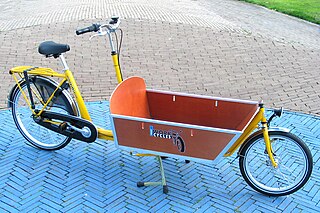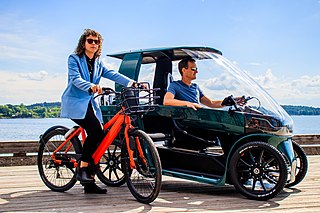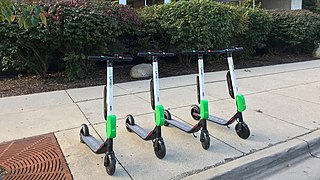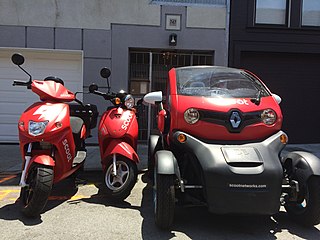Related Research Articles

There have been many human powered vehicles designed and constructed specifically for transporting loads since their earliest appearance in the 20th century. They are referred to variously depending on the number of wheels — typically two, three, or four — and by their specific use. Adjectives used to describe the tasks to which the bicycles, dicycles, tricycles, or quadracycles are put include cargo cycles, freight cycles, box cycles, carrier cycles, and so on. Sometimes they are also called cycletrucks, which uses a sense of the word 'truck' predating the automobile.

A bicycle-sharing system, bike share program, public bicycle scheme, or public bike share (PBS) scheme, is a shared transport service where bicycles are available for shared use by individuals at low cost.

A motorized bicycle is a bicycle with an attached motor or engine and transmission used either to power the vehicle unassisted, or to assist with pedalling. Since it sometimes retains both pedals and a discrete connected drive for rider-powered propulsion, the motorized bicycle is in technical terms a true bicycle, albeit a power-assisted one. Typically they are incapable of speeds above 52 km/h (32 mph), however in recent years larger motors have been built, allowing bikes to reach speeds of upwards of 72 km/h.

An electric bicycle, e-bike, electrically assisted pedal cycles, or electrically power assisted cycles is a motorized bicycle with an integrated electric motor used to assist propulsion. Many kinds of e-bikes are available worldwide, but they generally fall into two broad categories: bikes that assist the rider's pedal-power and bikes that add a throttle, integrating moped-style functionality. Both retain the ability to be pedaled by the rider and are therefore not electric motorcycles. E-bikes use rechargeable batteries and typically are motor-powered up to 25 to 32 km/h. High-powered varieties can often travel more than 45 km/h (28 mph).

A kick scooter is a human-powered street vehicle with a handlebar, deck, and wheels propelled by a rider pushing off the ground with their leg. Today the most common scooters are made of aluminum, titanium, and steel. Some kick scooters made for younger children have 3 to 4 wheels and are made of plastic and do not fold. High-performance kickbikes are also made. A company that had once made the Razor Scooters revitalized the design in the mid-nineties and early two-thousands. Three-wheel models where the frame forks into two decks are known as Y scooters or trikkes.
Many countries have enacted electric vehicle laws to regulate the use of electric bicycles, also termed e-bikes. Some jurisdictions have regulations governing safety requirements and standards of manufacture. The members of the European Union and other regions have wider-ranging legislation covering use and safety.

A motorized scooter is a stand-up scooter powered by either a small internal combustion engine or electric hub motor in its front and/or rear wheel. Classified as a form of micro-mobility, they are generally designed with a large center deck on which the rider stands. The first motorized scooter was manufactured by Autoped in 1915.

Electric motorcycles and scooters are plug-in electric vehicles with two or three wheels. Power is supplied by a rechargeable battery that drives one or more electric motors. Electric scooters are distinguished from motorcycles by having a step-through frame, instead of being straddled. Electric bicycles are similar vehicles, distinguished by retaining the ability to be propelled by the rider pedaling in addition to battery propulsion.

A dicycle is a vehicle with two parallel wheels, side by side, unlike single-track vehicles such as motorcycles and bicycles, which have two wheels inline. Originally used to refer to devices with large wheels and pedals, the term is now used in relation to powered self-balancing scooters with smaller wheels and no pedals such as the Segway PT and the self-balancing hoverboard.

A scooter is a motorcycle with an underbone or step-through frame, a seat, a transmission that shifts without the operator having to operate a clutch lever, a platform for the rider's feet, and with a method of operation that emphasizes comfort and fuel economy. Elements of scooter design were present in some of the earliest motorcycles, and motor scooters have been made since at least 1914. More recently, scooters have evolved to include scooters exceeding 250cc classified as Maxi-scooters.

Shared transport or shared mobility is a transportation system where travelers share a vehicle either simultaneously as a group or over time as personal rental, and in the process share the cost of the journey, thus purportedly creating a hybrid between private vehicle use and mass or public transport. It is a transportation strategy that allows users to access transportation services on an as-needed basis. Shared mobility is an umbrella term that encompasses a variety of transportation modes including carsharing, Bicycle-sharing systems, ridesharing companies, carpools, and microtransit.

Bay Wheels is a regional public bicycle sharing system in California's San Francisco Bay Area. It is operated by Motivate in a partnership with the Metropolitan Transportation Commission and the Bay Area Air Quality Management District. Bay Wheels is the first regional and large-scale bicycle sharing system deployed in California and on the West Coast of the United States. It was established as Bay Area Bike Share in August 2013. As of January 2018, the Bay Wheels system had over 2,600 bicycles in 262 stations across San Francisco, East Bay and San Jose.

Neutron Holdings, Inc., doing business under the name Lime, formerly LimeBike, is a transportation company based in San Francisco, California. It runs electric scooters, electric bikes and electric mopeds in various cities around the world. The system offers dockless vehicles that users find and unlock via a smartphone app that knows the location of available vehicles via GPS.
Superpedestrian Inc., is a transportation robotics company based in Cambridge, Massachusetts, that developed electrified and AI technologies for micro mobility vehicles. The company ran the LINK e-scooter sharing program, which was active in 57 cities across the US and Europe.

Mahindra GenZe, doing business as GenZe and also known as GenZe by Mahindra, was a brand of electric bicycles and scooters. It was a subsidiary of the Mahindra Group of India.

Scoot Networks, also known as just Scoot or Scoot Rides, is an American company which provides public electric scooter and electric bicycle sharing systems. The company is based in San Francisco, California.

A scooter-sharing system is a shared transport service in which electric motorized scooters are made available to use for short-term rentals. E-scooters are typically "dockless", meaning that they do not have a fixed home location and are dropped off and picked up from certain locations in the service area.

Micromobility refers to a range of small, lightweight vehicles, driven by users personally. Micromobility devices include bicycles, e-bikes, electric scooters, electric skateboards, shared bicycle fleets, and electric pedal assisted (pedelec) bicycles.

Cycling is a popular mode of transport and recreational sport in the Philippines.
China's first subway was constructed in Beijing in January 1970, nearly one hundred years after its initial development in London. By 1984, 66 major subway systems existed worldwide. Urban rail transit helped ease the immense pressure caused by urban traffic congestion, while allowing commuters to travel at great speed and convenience. Tianjin was the second city to have an urban rapid transit system and Shanghai was the third, the latter opening its Metro in 1995 that incorporated both subway and light railway lines.
References
- ↑ Schroeder, Bradley (January 3, 2014). Bicycle Sharing 101: Getting the Wheels Turning (1 ed.). Moonshine Media. p. 223. ISBN 9780987003492.
- ↑ Electric Two-wheelers in India and Vietnam: Market Analysis and Environmental Impacts. Asian Development Bank. 2009. ISBN 9789715618731 . Retrieved 11 June 2014.
- ↑ "Conclusion | Bicycle Sharing 101: Getting the Wheels Turning". bicyclesharing101.com. 2013-04-23. Retrieved 11 June 2014.